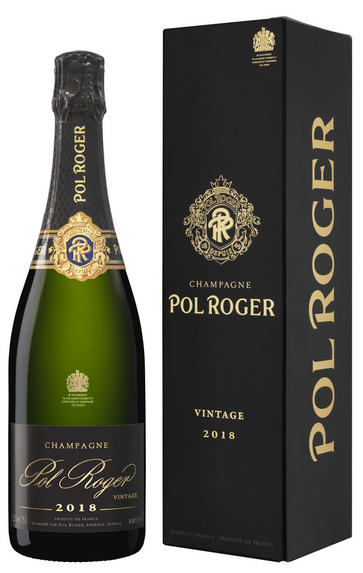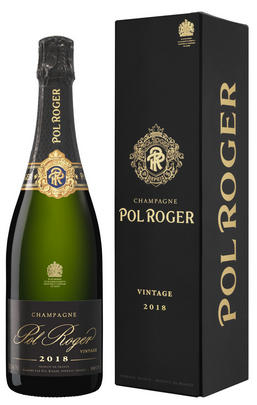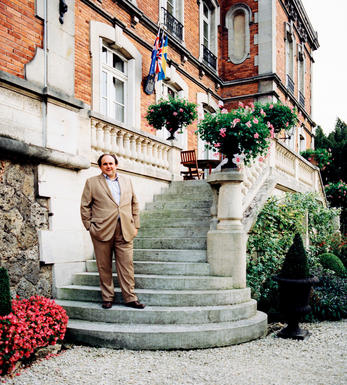
2018 Champagne Pol Roger, Brut

Critics reviews
The 2018 Vintage is a very pretty, open-knit Champagne to drink now and over the next 10-15 years. In a vintage in which so many wines are on the lighter side, the 2018 is super-expressive, with lovely depth and impeccable balance. The 2018 can be enjoyed now, but I would prefer to cellar it for a year or two. Hints of pear, dried flowers, kirsch and mint are nicely layered on a spine of fruit and structure.
Drink 2024 - 2038
Antonio Galloni, Vinous (March 2024)
Magnum served at Pol Roger's 175th anniversary celebration at Oswald's in London. It took four weeks to pick all the crop (cf 10 days for the 2023).
Very zesty with strong citrus notes. Still quite tight from magnum but very respectable. CEO Laurent d'Harcourt of Pol remarked that 'it had to be good after 2017' and that it was made in much bigger quantity. There was no 2016 and much is expected of the 2019.
Drink 2024 - 2036
Jancis Robinson MW, JancisRobinson.com (March 2024)
Pale lemon with a lively and persistent mousse and an attractive nose of Spring flowers, hawthorn and apple turnover, a hint of iodine too. Subtle and not thus far betraying the warmth of a generous vintage, the wine is composed yet incisive, fresh and yet profound, with orchard fruit and a citric cut shaping the palate, and notes of verbena and sourdough in support.
Expertly crafted and forthright, without indulging to excess, the 2018 is poised and confident but far from brash and with a clear potential to evolve gracefully. The wine broadens beautifully with a little time in the glass, with hints of honey and biscuit evidenced, and will do so equally impressively in bottle over the next five years and beyond.
I think this would score 93-95 points, the latter number reflecting how it will evolve and improve in the short to medium term
Simon Field MW, Decanter
About this WINE

Pol Roger
Pol Roger is perhaps best known as Winston Churchill's favourite Champagne. The house remains family-owned and has a reputation for producing champagnes of finesse and elegance which age very well. Pol Roger Brut Rèserve Non-Vintage, made from equal parts of Chardonnay, Pinot Noir and Pinot Meunier, is consistently one of the very best on the market, largely due to the high proportion of aged reserve wines in the blend.
Pol Roger vintage wines, made from at least 60% Pinot Noir and up to 40% Chardonnay, are soft and fruit-driven in youth but, after ten years or so, develop great complexity and finesse. The Cuvée Sir Winston Churchill, launched in 1984 and made from a secret blend, is a Champagne of exquisite finesse and balance and one that rivals the very best of the region.

Brut Champagne
Brut denotes a dry style of Champagne (less than 15 grams per litre). Most Champagne is non-vintage, produced from a blend from different years. The non-vintage blend is always based predominately on wines made from the current harvest, enriched with aged wines (their proportion and age varies by brand) from earlier harvests, which impart an additional level of complexity to the end wine. Champagnes from a single vintage are labelled with the year reference and with the description Millésimé.
Non-vintage Champagnes can improve with short-term ageing (typically two to three years), while vintages can develop over much longer periods (five to 30 years). The most exquisite and often top-priced expression of a house’s style is referred to as Prestige Cuvée. Famous examples include Louis Roederer's Cristal, Moët & Chandon's Dom Pérignon, and Pol Roger's Cuvée Sir Winston Churchill.
Recommended Producers : Krug, Billecart Salmon, Pol Roger, Bollinger, Salon, Gosset, Pierre Péters, Ruinart

Champagne blend
Which grapes are included in the blend, and their proportion, is one of the key factors determining the style of most Champagnes. Three grapes are used - Pinot Noir, Chardonnay and Pinot Meunier.
26% of vineyards in Champagne are planted with Chardonnay and it performs best on the Côtes des Blancs and on the chalk slopes south of Epernay. It is relatively simple to grow, although it buds early and thus is susceptible to spring frosts. It produces lighter, fresher wines than those from Burgundy and gives finesse, fruit and elegance to the final blend. It is the sole grape in Blancs de Blancs, which are some of the richest long-lived Champagnes produced.
Pinot Noir accounts for nearly 40% of the plantings in Champagne and lies at the heart of most blends - it gives Champagne its body, structure, strength and grip. It is planted across Champagne and particularly so in the southern Aube district.
The final component is Pinot Meunier and this constitutes nearly 35% of the plantings. Its durability and resistance to spring frosts make the Marne Valley, a notorious frost pocket, its natural home. It ripens well in poor years and produces a soft, fruity style of wine that is ideal for blending with the more assertive flavours of Pinot Noir. Producers allege that Pinot Meunier lacks ageing potential, but this does not deter Krug from including around 15% of it in their final blends.


Buying options
Add to wishlist
Description
This is comprised of 60% Pinot Noir and 40% Chardonnay.
The warmth of the vintage shows immediately on the nose, with prominent sweet pear and apple notes. There are subtle suggestions of shortbread and marzipan. The mousse is gentle and silky smooth, a hallmark of Pol Roger. The palate carries hints of redcurrants and raspberries from the Pinot Noir, along with a touch of lime citrus and salinity that Chardonnay from the Côte des Blancs provides. Baking spices and fresh pastry characters unfurl with time in the glass.
This provides almost immediate drinking pleasure – but with five years in the cellar, it will be sublime.
Drink 2026 - 2036
Paul Keating, Senior Account Manager, Berry Bros. & Rudd (March 2024)
wine at a glance
Delivery and quality guarantee